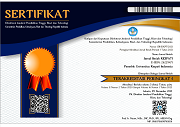- Focus and Scope
- Section Policies
- Peer Review Process
- Open Access Policy
- Archiving
- ARTICLE TEMPALTE
- PUBLICATION ETHICS
- ARTICLE PROCESSING CHARGES
- Plagiarism Check
- Archiving
- Content License
Focus and Scope
Jurnal Ilmiah Respati Adalah jurnal ilmiah Fakultas Pertanian Universitas Respati Indonesia yang menyampaikan hasil-hasil penelitian dan informasi ilmiah di bidang pertanian.
Fokus dan Scope dari Jurnal Ilmiah Respati adalah :
- Ilmu pertanian
- Ilmu tanah
- Benih
- Hama dan penyakit tanaman
- Pemuliaan tanaman
- Pangan
- Gizi
- Kesehatan
Section Policies
Articles
Peer Review Process
The manuscripts submitted to Jurnal Ilmiah Respati (e-ISSN: 2622-9471) will be evaluated through 2 review stages by an editor and reviewers.
The first is the pre-review by the journal editor to evaluate the conformity of the manuscript with the focus and scope of the journal and the specific author guidelines. Jurnal Ilmiah Respati uses Google Scholar and Turnitin software for plagiarism and similarity checking during this stage. Duration of evaluation between 1-3 weeks.
Each manuscript that passes the first stage will be substantially Double-blind reviewed by at least two reviewers. Duration of evaluation between 8-24 weeks after review assignment. The reviewer may request a re-review after the author revises his/her article. The editor will send the reviewers' comments to the corresponding author to take the necessary revisions.
The Editor decides whether the revised manuscript can be published by considering recommendations from reviewers. All pre-published articles must be free from plagiarism content. The Editor will check the similarity of articles in this journal using Turnitin software. All accepted articles will be first published in the Jurnal Ilmiah Respati.
Open Access Policy
This journal provides immediate open access to its content on the principle that making research freely available to the public supports a greater global exchange of knowledge.
Archiving
This journal utilizes the LOCKSS system to create a distributed archiving system among participating libraries and permits those libraries to create permanent archives of the journal for purposes of preservation and restoration. More...
ARTICLE TEMPALTE
JOURNAL TEMPLATE
respati scientific journals
respati scientific journals (JIR)original scientific papers (articles, reviews / reviews, case study reports, book reviews, or matters relating to groups of health science groups. The article has not been published or is in the process of being submitted for publication in another journal or magazine.
PEER REVIEW ARTICLE
Articles that have been sent to the journal will be reviewed related to the technical writing and substance of the article by at least 2 (two) reviewers.
ORIGINALITY AND PLAGIARISM
The author of the article must ensure that the manuscript sent is his own work and free of plagiarism. All the texts that will be published will be checked for similarity using antiplagiarism software.
1. Systematics of Writing
a. Initial section: title (maximum 20 words; 14 pt), author's name (without title), origin of institution / institution, email, abstract (written in Indonesian and / or English. Abstracts are arranged in words not exceeding 250 words using Calibri font size 11 pt single space. On the abstract page there are minimum keywords of 3 words and a maximum of 9 words.
b. The main part: contains the introduction, literature review and development of hypotheses (if any), methods / methods of research, results of research and discussion, and conclusions and suggestions.
c. The final part: thank you, symbol description (if any), and bibliography
2. Layout
Manuscripts are written on A4 paper with the margin format as follows:
a. Margin of 2.5 cm
b. Margins below 2.0 cm
c. Left margin 2.5 cm
d. Right margin of 2.0 cm
Each text has a maximum of 10 pages (including tables, images and reference lists) with a single spacing, Calibri font, size 11 pt.
b. Language, Unit and Symbol
Manuscripts written in Indonesian are standard, straightforward and clear. The use of units and symbols refers to the rules of the National Standards and International Units (SI).
Equations Writing
Equations or formulas are written using software equestion and are numbered, for example:
Ω = 2 πr ……………………………. (1)
Writing equations in text is stated by Press. (1).
Pictures and Tables
Images and Tables are printed in black and white. Writing pictures and tables like the example below.
Figure 1. Caption (below center) and Table 1. Description of the table (in the upper middle). In the text written in Fig. 1. and Table 1.
3. List of references
The reference list is written in the order in which it appears in the text using Vancouver Systems (numbers in square brackets). Reference includes initials and author's name (anonym), journal name or book name, volume, editor, publisher, city, year, and page.
Example Reference List:
Paper in the Journal:
[1] E. Yusron. Jurnala Makara Sains 10, (2006) 41.
[2] G. Smith. Thin Solid Films (to be published).
Electronic Publication, Internet Information:
[3] S. Auzary, K.F. Badawi, L. Bimbault. Phys. Rev. Lett. 68 (2008) 2912. Hep-th / 9112009.
[4] L. Weiss. Instruction to Authors, Elsevier Publishing, http: /www.elsevier.com/authors.html 1999.
Publication of Conference Proceedings:
[5] C.H. Perry, F. Lu, F. Namavar, N.M. Accounting. Material Res. Soc. Symp. Proc. 256 (2005) 132.
[6] J.J. Favier, D. Camel. Proceedings of the Eight International Conference on Crystal Growth, York, U.K., 2006, p.58.
Monograph, edited book:
[7] D. Falix [Ed.] Handbook of Optical Constants of Solid II, 3rd Ed., Academic Press, New York, 1991, p.253.
[8] S.M. Sze. The Physics of Semiconductor Devices, Wiley, New York, 1981, p. 345.
Thesis and Dissertation:
[9] R. Ramos. Ph.D. Thesis, College van Dean, University of Twente, Netherland, 1991.
[10] S. Badu. Undergraduate Thesis, Department of Chemistry FMIPA, University of Indonesia, 2008.
Patent:
H. Yamagushi, A. Hiroe, H. Nishio. Japan Patent No. 5264701, November 23, 1993.
Industry Report Paper:
[11] R.D. Nicholson. International Structures in Nickel-based Transitions After Long Term Service Joints, RD / M / N1131 Reports, Central Electricity Generating Board, Marckwood, 2005.
[12] J. Cleveland. Constant Spring Update, Digital Instrument, Santa Barbara, 1987. [If there is a Website address can be added with Italic letters]
Special Data [If the author is a team or synonym]:
[13] Joint Committee on Powder Diffraction Standards, Powder Diffraction Files, ASTM, Philadelphia, 1967, Card 4301027.
[14] Anonymous. 19th Annual Book of ASTM Standards Part 17, ASTM Philadelphia, 1969, p. 457.
Unpublished results (referenced if necessary):
[15] D.H. Smith. Physics Department, Chicago University, Chicago, U.S.A., Private Commun, 1966.
[16] R. Stumpf, X. Gonze. Fritz-Haber Institute Research Report, 2006, Unpublished.
Email: jbik@urindo.ac.id; lppm@urindo.ac.id
Online registration and submission: http://ejournal.urindo.ac.id/index.php/JIR, C.p: 08122504356; 089691155082
The author will receive a notification if the manuscript is received and will be published in the journal in the form of an acceptance letter. After getting the certificate, the author must make a payment of Rp. 500,000.00 through a BNI account: No. 1020519402.
JOURNAL OF HEALTH SCIENCE (JBIK)
eISSN 2622-948X; pISSN 1693-6868
Publish 2 (two) times every year
(June and December)
Example:
ARTICLE TITLE (no more than 20 words, using Capital Each Word, 14 pt, bold, center),
Corresponding Author 1, Author1, and author2 (11pt)
1 position of the author at the first supporting institution (11pt)
2 the position of the author at the second supporting institution, if any (11pt)
main author email address (11pt)
Abstract (maximum 250 words) (Indonesian)
…………………………………………………………………………………………………………………………………………………………………………………………………………………………………………………………………………………………………………
Keywords: ............................................... .................................. (3-9 words; calibri 11 pt)
Abstract (maximum 250 words) (english)
…………………………………………………………………………………………………………………………………………………………………………………………………………………………………………………………………………………………………………
Keywords: ............................................... .................................. (3-9 words; calibri 11 pt)
INTRODUCTION (11 PT, BOLD)
Paper is written with Calibri, size 11 and in A4 document format (210mm x 297mm) with an upper margin of 2.5 cm, bottom: 2cm, left 2.5 cm and right: 2 cm, flat right - left. Fill in the document, including tables, graphs, images cannot be more than 10 pages. The title must be short, informative and no more than 20 words. Articles are made into two columns.
The introduction contains the background to why the research was conducted, problem formulation, literature review and information related to the writing. The part of the introduction is the background, problem formulation, research objectives and the benefits of the study
METHOD
Contains the design of the study, a description of the ways in which the implementation of the study includes the population and samples, instruments and methods of data collection, data analysis techniques. The results present the data characteristics and research findings.
RESULTS AND DISCUSSION
The results of the study contain a brief statement about the results of the study. While the discussion contains a discussion that connects and compares the results of research with the theory and results of previous research.
QUOTES: Writing quotations by mentioning the source, namely by writing the author's last name along with the year of publication of the book. Quotes can be done in a direct way, summarizing.
TABLE: The table title is written in size 11, bold. Like the example below. Numbering table names using Arabic numbers. Among the table and table titles are not spaced. The contents of the table are written in Calibri letters size 11, and with 1 space format. While the Image Title is placed under the image in a format such as the table title.
Table 2. Respondent Characteristic Analysis
RT | Clean and Healthy Lifestyle | |
PHBS | Non PHBS | |
1 | 45 | 76 |
2 | 17 | 23 |
3 | 12 | 23 |
4 | 47 | 30 |
5 | 24 | 16 |
6 | 12 | 18 |
Total | 157 | 186 |
Source: Pasar Rebo District Health Center Profile
Figure 1 ODHA Survival Curves with
Treatment Compliance
CONCLUSIONS AND RECOMMENDATIONS
The concluding section consists of Conclusions and Suggestions based on the results of the study
Acknowledgement (IF ANY)
This part contains acknowledgment or gratitude to the parties who play a role and are involved in the implementation of research / article writing (donor / sponsor), both material and other facilities.
REFERENCES (11 PT, BOLD)
All articles referred to are written in the Bibliography with the provisions (Vancouver System) as follows: Space spacing is used 1 space, the second row of each article begins jutting in with 6 beats. The distance between articles is 1 space. Article Writing Order by number. The author's name is written without a title, starting from the last name (family name), written in full, followed by his first name, abbreviated and does not need to be sorted alphabetically. No need to sort the year of publication of writing. Use of bibliography in the last 10 years for references from books and the last 5 years for journals.
(only written in accordance with the citations listed in the publication text only)
It is recommended to use the Application Reference Management Tool like Mendeley and others.
PUBLICATION ETHICS
PUBLICATION ETHICS
A. Journal Identity
JIR (Jurnal Ilmiah Respati) (e-ISSN: 2622-9471) is a review journal published by the Institute for Research and Community Service of the University of Respati Indonesia. This statement explains the ethical behavior of all parties involved in the process of publishing an article in this journal, including the author, chief editor, Editorial Board, reviewer and publisher.
B. Publisher Responsibilities
1. Publishers Jurnal Ilmiah Respati are responsible for publishing articles that have gone through the process of editing, reviewing, and laying in accordance with the rules of publishing Scientific Journals
2. Publisher Jurnal Ilmiah Respati are responsible for guaranteeing the academic freedom of writers, editors, and partners in carrying out their respective duties
3. Publishers Jurnal Ilmiah Respati are responsible for maintaining privacy and protecting intellectual property and copyrights, and freedom of testimony
C. Editorial Responsibilities (board editor)
1. Editorial Jurnal Ilmiah Respati in deciding appropriate texts is published through editorial board meetings (consisting of editors, editors, and reviewers) that refer to the substantive results of articles and applicable legal requirements regarding defamation, copyright infringement, duplication , data fabrication, data falsification and plagiarism
2. In the process of reviewing and receiving the manuscript, the editorial team of the Journal of Jurnal Ilmiah Respati based on the principle of equality of treatment in making decisions to publish the text by not distinguishing the race, gender, religion, ethnicity, citizenship or political ideology of the author.
3. Editorial Team The Jurnal Ilmiah Respati will not disclose any information about the manuscript or manuscript entered except with the author's permission
4. Unpublished manuscripts will not be used by editorial research of the Jurnal Ilmiah Respati for their own purposes
D. Responsibilities of Mitra-bestari
1. Partner-bestari Jurnal Ilmiah Respati assist editors in making editorial decisions on incoming texts / texts
2. Partner-bestari Jurnal Ilmiah Respati are responsible for the recommendations of the manuscript they have reviewed
3. The study of the manuscript is carried out objectively and supported by clear arguments
4. Partner-bestari The Jurnal Ilmiah Respati are responsible for examining the quotations, references, duplications, fabrication of data, falsification of data and plagiarism of the texts that are reviewed
5. In carrying out inspection tasks in points (4) above, partners are best-sellers by the editor team
6. Partner-bestari Jurnal Ilmiah Respati must always maintain the confidentiality of information and not use information from the manuscript that it examines for personal gain / interest
E. Author's responsibility
1. The author must present the text of his thoughts or research clearly, honestly, and without duplication, data fabrication, data falsification and plagiarism or auto-plagiarism
2. The author is responsible for the confirmation submitted for the written text
3. The author must show references from the opinions and works of others quoted
4. The author must write the script ethically, honestly and responsibly, in accordance with the rules of writing scientific works in force
5. The author does not object if the text is edited in the process of review and layout without changing the substance or main idea of the writing
Editor's Address:
Jalan Bambu Apus I No. 3 Cipayung East Jakarta 13890, tel. 0218457627, http://ejournal.urindo.ac.id/index.php/pertanian
p-ISSN: 1411-7126, online-ISSN: 2622-9471
ARTICLE PROCESSING CHARGES
This journal charges the following author fees.
Article Submission: 0.00 (IDR)
Authors are required to pay Article Submission Fees as part of the submission process to contribute to review fees.
Fast Track Reviews: 0.00 (IDR)
With payment of these fees, reviews, editorial decisions and author's notices in this manuscript are guaranteed to take place within 4 weeks.
Publication Article: Rp 400.000 (IDR)
If the Writer wants a printed version, an additional fee of Rp 100.000 / Expansion (including post) is charged
Plagiarism Check
Plagiarism is a threat to scientific publishing in general and Jurnal Ilmiah Respati in particular. The originality of submitted work can be ensured through plagiarism screening and rejection of suspected material. For maximum effectiveness, all articles submitted to Jurnal Ilmiah Respati must go through a plagiarism detection process before submission.
Archiving
Jurnal Ilmiah Respati (E-ISSN: 2622-9471) provides immediate open access to its content, based on the principle that making research publicly available supports a broader global exchange of knowledge. Published articles will be available on the Jurnal Ilmiah Respati website, and the full text can be downloaded free of charge. * PKP Publication Network (PKP PN). See info. * Portico archive
Content License
Jurnal Ilmiah Respati allows readers to read, download, copy, distribute, print, search, or link to its articles’ full texts and allows readers to use them for any other lawful purpose. The journal allows the author(s) to hold the copyright without restrictions. Finally, the journal allows the author(s) to retain publishing rights without restrictions
- Authors are allowed to archive their submitted article in an open access repository
- Authors are allowed to archive the final published article in an open access repository with an acknowledgment of its initial publication in this journal

This work is licensed under a Creative Commons Attribution-ShareAlike 4.0 Generic License.













